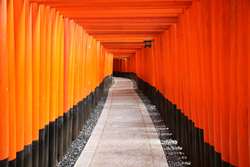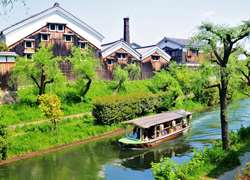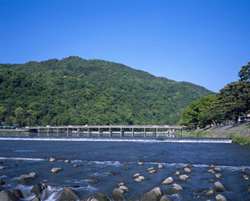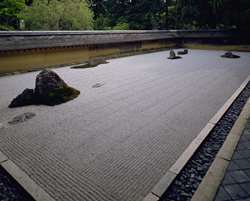We hope that you will join us on one of the four exciting excursions that we have to offer. Please note that a bus will pick you up in front of the ICC Kyoto (Kyoto International Conference Center) at noon on Wednesday. Due to change of the venue of conference dinner, all excursions will take you back directly to the ICC Kyoto for the conference dinner. English Speaking Guide will accompany the all tours.
Reserve Your TOUR Now
(Guide fee, Lunch, Transportation, Entrance fee is included in the fee)
*The minimum number of guests: 20 persons
*The maximum number of guests: 60 persons
Kyoto Handicraft Center
Kyoto Handicraft Center has plenty of high-quality goods that make for the perfect souvenirs for the folks back home. While we’re particularly partial to the woodblock prints, you’ll also find such things as yukata (light cotton robes like the ones you wear at your ryokan), pottery and jewelry.
Kinkakuji (Golden Pavilion)
Kinkakuji (Golden Pavilion) is a Zen temple in northern Kyoto whose top two floors are completely covered in gold leaf. Formally known as Rokuonji, the temple was the retirement villa of the shogun Ashikaga Yoshimitsu, and according to his will it became a Zen temple of the Rinzai sect after his death in 1408.
Nijo Castle
Nijo Castle (Nijōjō) was built in 1603 as the Kyoto residence of Tokugawa Ieyasu, the first shogun of the Edo Period (1603-1867). His grandson Iemitsu completed the castle’s palace buildings 23 years later and further expanded the castle by adding a five story castle keep.
(Guide fee, Lunch, Transportation, Entrance fee is included in the fee)
*The minimum number of guests: 20 persons
*The maximum number of guests: 60 persons
Kyoto Handicraft Center
Kyoto Handicraft Center has plenty of high-quality goods that make for the perfect souvenirs for the folks back home. While we’re particularly partial to the woodblock prints, you’ll also find such things as yukata (light cotton robes like the ones you wear at your ryokan), pottery and jewelry.
Fushimi Inari Shrine (Fushimi Inari Taisha)
Inari Shrine (Fushimi Inari Taisha) is an important Shinto shrine in southern Kyoto. It is famous for its thousands of vermilion torii gates, which straddle a network of trails behind its main buildings. The trails lead into the wooded forest of the sacred Mount Inari, which stands at 233 meters and belongs to the shrine grounds
Gekkeikan Okura Sake Museum
This museum on sake-making is run by the Gekkeikan Sake Company, Ltd., one of Japan’s preeminent sake companies. Opened in 1982, it is housed in an old sake brewery that was built in 1909, and presents the history of sake in Japan and sake production in Fushimi in an easy-to-understand manner.
(Guide fee, Lunch, Transportation, Entrance fee is included in the fee)
*The minimum number of guests: 20 persons
*The maximum number of guests: 120 persons
Bamboo Grove
The Arashiyama Bamboo Grove is one of Kyoto’s top sights and for good reason: standing amid these soaring stalks of bamboo is like being in another world. If you’ve been planning a trip to Kyoto, you’ve probably seen pictures of the Arashiyama Bamboo Grove – along with the torii tunnels of Fushimi-InariTaisha Shrine and Kinkaku-ji Temple, it’s one of the most photographed sights in the city.
Togetsu Bridge
Togetsukyo is a 155-meter bridge over the Katsura River flowing leisurely in Saga Arashiyama, a well-known scenic place in the ancient capital of Kyoto. The artistic form of the bridge excellently matches the nature and is a symbol of sightseeing in Kyoto as embodying the aesthetic sense of Japanese people.
Ryoanji Temple
Ryoanji Temple (Ryōanji) is the site of Japan’s most famous rock garden, which attracts hundreds of visitors every day. Originally an aristocrat’s villa during the Heian Period, the site was converted into a Zen temple in 1450 and belongs to the Myoshinji school of the Rinzai sect of Zen Buddhism, whose head temple stands just a kilometer to the south.
(Guide fee, Lunch, Transportation, Entrance fee is included in the fee)
*The minimum number of guests: 20 persons
*The maximum number of guests: 120 persons
Ujibashi Bridge, Byodo-in Omotesando Street
A sign by the road proudly declares it to be one of the oldest bridges in Japan, which is partially true as a wooden bridge was first built here in 646. Since then, the Uji-bashi Bridge has been celebrated in art and literature, fought over in war, destroyed by fires and disasters and rebuilt numerous times. Viewing the modern incarnation of wood-trimmed concrete and steel though, one might wonder what all the fuss is about.
Byodoin Temple
Byodoin Temple is a striking example of Buddhist Pure Land (Jodo) architecture. Together with its garden, the temple represents the Pure Land Paradise and was influential on later temple construction. Byodoin was initially built in 998 as a countryside retreat villa for the powerful politician Fujiwara no Michinaga, not as a temple. The hall is now featured on the Japanese ten yen coin.
Daigoji Temple
Daigoji is an important temple of the Shingon sect of Japanese Buddhism and a designated world heritage site. The large temple complex stands southeast of central Kyoto and includes an entire mountainside. The main temple grounds are located at the base of the mountain and are connected via a hiking trail to several more temple buildings around the summit.
